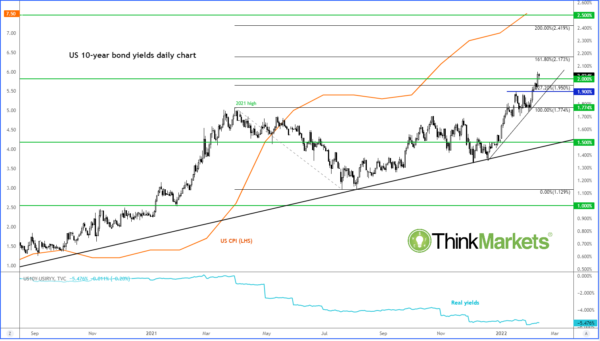It has been one hell of a week in the markets, and a Super Thursday for volatility. Consumer inflation once again exceeded expectations in the US, rising to its highest level since 1982 at 7.5 per cent. This caused at least one Fed official to panic and investors ramped up their rate hike bets. The result? Yields spiked and expensive technology stocks led a slump on Wall Street. But at the time of writing on Friday morning, dip buying saw the major US indices rebound. It remains to be seen whether the bulls will be able to defend their ground, however, given Thursday’s events.
How high will yields go?
At just over 2.0%, the 10-year yield is way lower than the 7.5% inflation rate. This means that real yields are actually -5.5%. This is bizarre, to say the least. The Fed’s QE programmes and strong foreign demand for US debt are the main reasons for this mis-match. The question is, why aren’t yields higher? Is it because the market is expecting nominal inflation rates to fall back, and quickly? Perhaps. Even if inflation falls back to around 3%, real yields would still be negative. Therefore, it is reasonable to expect yields to catch up with inflation. I reckon we will be heading towards 3.00% on the 10-year in the coming weeks, the speed of which will depend on incoming data and whether more Fed officials will turn as hawkish as Bullard. This should keep tech stocks under pressure, but support financials.
How many rate hikes?
The strong CPI print was a game changer on Thursday. The market is now eyeing about 7 rate increases of 25 basis points apiece, starting from March. There is a good chance, however, that we will see a 50 basis point hike in March, judging by the rates futures and Bullard’s comments. If the Fed becomes concerned about the economy falling into a wage-price spiral, then it is even possible we could see more hikes. But it all depends on incoming data.
Key economic highlights
In the week ahead, there won’t be an awful lot in the way of US macro pointers or Fed speeches, although we will still have PPI and FOMC meeting minutes to look forward to. The key question is what will happen to yields, which will, of course, have repercussions for other financial markets, not least US tech stocks. It is possible that if we see a stronger-than-expected PPI print that this will lead to further strength for yields.
Here are the week’s data highlights:
Monday
- Japan GDP q/q
- UK average earnings and jobless claims
- Eurozone quarterly GDP and employment change estimates; German ZEW Economic Sentiment
- US PPI and Empire State Manufacturing Index
- CPI estimates from China, UK and Canada
- US retail sales, industrial productions and FOMC meeting minutes
- Australian employment data
- FedSpeak: FOMC members Bullard and Mester
- Retail sales data from UK and Canada
- FedSpeak: FOMC members Waller and Williams
Chart to Watch: 10-year bond yields
Source: ThinkMarkets and TradingView.com
Clearly, all the focus will be on the 10-year yields after breaking through the 2.00% barrier. How high will it go and how fast will have ramifications for the rest of the financial markets.














